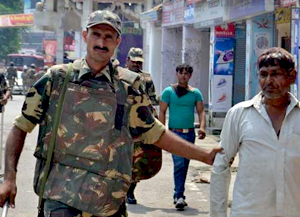 Lucknow, Sep 14: The brutality with which people were massacred in west UP clashes has shaken even the doctors at Muzaffarnagar district hospital who performed the postmortem of victims. The tales told by the doctors are horrific: a woman dismembered into two parts, charred bodies whose sex could not be ascertained and a ten-year-old kid whose head was smashed.
Lucknow, Sep 14: The brutality with which people were massacred in west UP clashes has shaken even the doctors at Muzaffarnagar district hospital who performed the postmortem of victims. The tales told by the doctors are horrific: a woman dismembered into two parts, charred bodies whose sex could not be ascertained and a ten-year-old kid whose head was smashed.
A 12-member team of doctors has been working round the clock since September 7, conducting autopsy of victims of the state's deadliest communal clashes.
So far, doctors have conducted postmortem of 53 victims. While 40 bodies were identified, 13 were beyond recognition. The team is doing autopsy of three to four corpses daily. The official toll climbed to 45 on Friday.
On Friday, two highly decomposed bodies of men were brought to the hospital from Bhopa and Sikhera police stations. Both the victims could not be identified. Doctors said most of the riot victims were either stabbed or attacked with sharp-edged weapons.
Recounting the horror, a senior doctor posted at the hospital said, "A family of four was killed brutally in Phugana town of Shamli. A woman was cut into two pieces. Cops brought her torso and abdomen separately to the hospital. It seemed the rioters had axed her and damaged her face with multiple blows of the weapon."
The doctors said in Phugana, victims were targeted by rioters with wreaking vengeance. "Two severely charred bodies, including that of an eight-year-old kid, were brought to the hospital on September 10. Their sex could not be determined but we have preserved DNA samples for further examination," said a doctor. DNA samples of 11 more riot victims have been preserved. Several houses in the village were torched in the communal violence. Maximum charred bodies came from Phugana. At least 16 people from Phugana are feared dead.
Another pocket targeted by rioters was Kutba, a village in Shahpur area of Muzaffarnagar. The victims in this village were attacked with firearms, sharp-edged weapons and wooden sticks.
The administration has told doctors to speed up the autopsy process. So postmortems are being conducted in the night as well. But doctors complain the government is not sending additional teams of doctors from Shamli.
"Health department despite reminders did not ensure that some doctors from Shamli help us in taking care of patients. Serious cases from the neighbouring district are referred to Muzaffarnagar district hospital and we remain extremely overburdened," said a doctor.
"Dissecting body of the charred kid left me in shock and I could not have proper meal for the next 24 hours. I had never seen brutality of such magnitude before," said a doctor. Twenty one critical cases were brought to the hospital, out of whom 20 survived.





Comments
Add new comment